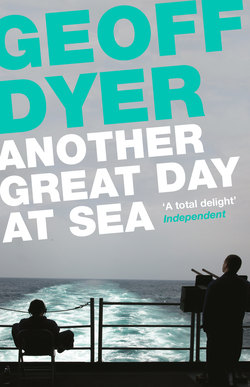Читать книгу Another Great Day at Sea - Geoff Dyer - Страница 8
На сайте Литреса книга снята с продажи.
Оглавление3
After all I’d heard about the size of these carriers I’d assumed there would be an abundance of facilities. Ping-Pong tables—and the prospect of a table-tennis league—were such a cert that I’d actually brought my paddle with me. Badminton seemed likely and, though this might have been a tad optimistic, I even had hopes of a tennis court. The reality is that a carrier is as crowded as a Bombay slum, with an aircraft factory—the hangar bay—in the middle. The hangar bay is the largest internal space on the boat. It’s absolutely enormous—and barely big enough for everything going on there.
Just past the hatch through which we entered a dozen men and women in shorts and singlets, all plugged into their iPods, were pedalling away on exercise bikes or running on treadmills. It was like stepping into a future in which the technology of renewable energy had advanced to the point where their efforts powered the whole ship. There was even a statue of someone running: George Bush Sr., of course, in flying suit and kit, scrambling for his plane back in the Second World War when he was a Navy pilot. Fuel tanks were hung from ceiling and walls. Every bit of space was utilized in the same way that my dad, on a smaller scale, maximized space in his garage (never trusting me, as a result, to park his car there after I’d borrowed it). The planes were nuzzled up close to each other. Mechanics were clambering all over them, with special soft moccasins over their boots to prevent damage. Each of the planes had a pilot’s name stencilled just below the cockpit where, in the Second World War, Japanese flags or swastikas would indicate kills. But the fact that Dave Hickey had his name here did not mean that it was Hickey’s plane for his exclusive use (which made me wonder what the point was of having his name there at all; I mean, when you write your name on the milk carton in the fridge of a shared student house you do it to indicate that it’s your milk, that it’s not for anyone to take a big gulp of or to pour over a bowl of Crunchy Nut Corn Flakes just because they’ve got the munchies).
I was working my way through this analogy-reminiscence when we were met by Commander Christopher Couch whose businesslike pleasure it was to take us on a tour of this massive—and massively crowded—space. He was in his mid-forties, I guessed, and his hair was cut like everybody else’s on the ship. I always like to be in the presence of people who are good at and love their jobs—irrespective of the job—and if ever there was a man in love with his job it was Couch. He began by explaining that the E-2C Hawkeye had an eight-bladed prop and that this had only recently been made possible by advances in materials technology. Made sense. I thought back to First World War biplanes with their twin-bladed props and maximum speeds slightly faster than a bike’s. I had no chance to make notes; there was so much to see and it was impossible to keep up with all the model numbers, engine parts, fuels, tools and spools, functions and processes and purposes, many of them dissolving in a torrent of acronyms.
‘Wow,’ I said during a brief lull in Couch’s litany. ‘This is the most A-I-E I’ve ever been in.’
‘Excuse me?’
‘Acronym Intensive Environment,’ I said, feeling both smart and stupid at having risked a first joke in a new place.
‘That’s a good one,’ said Couch in a tone suggesting that there are only bad ones.
Light was pouring in through huge spaces on either side of the hangar: the port and starboard elevators that took planes up to the flight deck. The sea was racing past, a film of light and sky projected from within this vast and silhouetted auditorium. I would like to have watched more of this nautical epic but we were not here to admire the view. Couch’s recitation of specs and engine parts, however, was occasionally punctuated by mention of something I could humanly relate to: the beach. It came up several times, this beach, but he wasn’t taking a detour into how he liked to spend his vacation—he was talking about ‘the long logistical pipeline back to the beach’. Ah, he was still on the job; the beach was the mainland where spares were kept and more complex repairs could be made. I started calculating ways in which I might incorporate this bit of metonymy into dinner-party chat back at London beach. I couldn’t think of a single way, but I liked the logic of his usage, the way it performed two tasks simultaneously. It made the deployment seem like a pleasure cruise (if you love your job this much it is sort of a paid vacation) and it also did the opposite: made everything that happened on the mainland seem like buckets-and-spade stuff, a holiday, compared with the serious shit that went on here.
We came to the other end of the hangar, near the very back of the boat, the fantail as they call it in the trade. This was where the jets’ engines were tested. At night, a full test would take about eight hours, and it was a source not of amazement but of incomprehension to Couch that anyone would contemplate missing a single minute of this epic performance without concluding that their lives had been thoroughly wasted.
